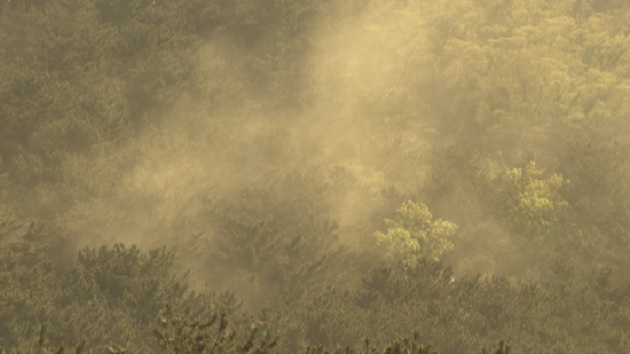
The biggest spring allergy trigger is pollen.
Cedar trees had been releasing pollen until early April in Jeju. Now, pine trees are discharging their tiny grains into the air.
Pollen can affect the sinuses and respiratory tract, so people are advised to be careful to minimize exposure.
Mike Balfour reports.
Greenish-yellow dust is blown and spread around by the wind.
Cars are covered with yellow particles.
That’s the biggest spring allergy trigger, pollen, which is the reproductive particle produced by male plants.
The pollen of cedar trees is the biggest trigger of springtime allergies.
When the tiny pollen grains get into the nose of someone who’s allergic, the body’s defenses go haywire.
INTERVIEW
Kang Ju-wan / Head, Jeju National University’s Environment and Health Center
The tiny pollen grains trigger the runny nose, stuffy nose and sneezing in the upper respiratory tract. And at the lower tract, they cause trouble breathing and allergic asthma.
<인터뷰 : 강주완 / 제주대학교 환경보건센터장 >
"상기도에서는 주로 콧물이나 코막힘, 재채기 같은 비염의 형태로 나타나고요. 하기도로 들어갔을 때는 호흡 곤란이나 기침 같은 천식의 증상으로 (알레르기가) 나타나게 됩니다."
The pollination season of cedar trees ends early April.
Following the cedar trees, pine trees pollinate between mid-April and June.
Weather conditions affect pollen levels. Because pollen is small and light, it can be easily spread by wind when it’s dry.
According to the Korea Meteorological Administration, the pine tree pollen level in Jeju was “High” or “Very high” as of April 30.
The number of patients who see a doctor for symptoms of pollen allergies-stuffy nose, rhinitis, or asthma- is growing.
The number peaks when cedar and pine trees pollinate.
Pine tree pollen had been known to be harmless, but allergens are recently becoming heavier in pine tree pollen grains.
INTERVIEW
Kang Ju-wan / Head, Jeju National University’s Environment and Health Center
It’s almost impossible to avoid pollen. But you need to be informed of weather information. Try to stay indoors whenever the pollen count is very high. Statistics show that the count is the highest between 6AM and 10AM, so stay indoor during the hours.
<인터뷰 : 강주완 / 제주대학교 환경보건센터장 >
"완벽하게 피하는 건 사실 쉽진 않을 겁니다. 하지만 요새는 예보 시스템이 잘 돼 있기 때문에 꽃가루 농도가 높은 날은 가급적이면 외출을 삼가신다든지. 오전 6시부터 10시까지가 꽃가루 농도가 가장 높은 것으로 돼 있습니다. 그래서 그 시기를 피해서 외출을 하신다든지."
As the weather is becoming warm, outdoor activities are expected to expand. Experts advise to stay indoors when the pollen level is high, and wear sunglasses and a face mask in the open-air.
Mike Balfour, KCTV





